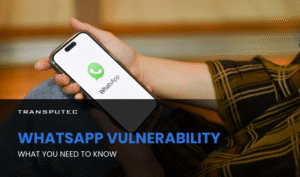Written by KRITIKA SINHA | MARKETING
Third-party data breaches have become a significant concern for businesses of all sizes. These incidents occur when cybercriminals exploit vulnerabilities in your vendors’ or partners’ systems to gain unauthorised access to your sensitive data.
In this blog, we’ll explore the risks associated with third-party data breaches and how Transputec can help protect your business.
What is an AiTM Phishing Attack and How to Fight Back?
Transputec helps mitigate third-party data breach risks through a comprehensive approach that includes thorough vendor risk assessments to identify potential vulnerabilities in the supply chain. We provide continuous monitoring of the third-party ecosystem using advanced tools to detect suspicious activities or potential breaches in real-time.
We also offer expert-led security awareness training programs like Cybsafe to educate employees about the risks and best practices for prevention.
Understanding Third-Party Data Breaches
Third-party data breaches are a growing threat in today’s interconnected business landscape. These incidents occur when cybercriminals exploit vulnerabilities in your vendors’ or partners’ systems to gain unauthorised access to your sensitive data. The consequences can be severe, with potential financial losses, reputational damage, and legal repercussions.
Recent studies have shown that 61% of organisations experienced a third-party data breach in 2023, a staggering 50% increase from the previous year. This alarming trend highlights the urgent need for businesses to prioritise their third-party risk management strategies.
“At Transputec, we understand the critical importance of protecting your data from third-party breaches."
Why Are Third-Party Data Breaches So Dangerous?
1. Indirect Control Over Vendors:
Companies often do not have direct control over third-party security measures. This lack of visibility creates gaps in compliance and cybersecurity, leaving you vulnerable to data breaches.
2. Increased Attack Surface:
Each third-party relationship expands the attack surface, providing hackers with more potential points of entry. This could include anything from a cloud provider to a software vendor.
3. Reputational and Financial Loss:
When sensitive customer or business data is exposed due to a third-party breach, it reflects poorly on your organisation, regardless of who is at fault. For businesses, this can result in a loss of customer trust, legal liabilities, and severe financial penalties.
Real-Life Example: The Target Breach
One of the most infamous third-party data breaches occurred in 2013 when retail giant Target was hacked through a third-party vendor. Hackers gained access to 40 million payment card details by exploiting weaknesses in the HVAC contractor’s system, leading to a $18.5 million settlement. This breach underscored how even small vendors can cause massive damage when security measures are not up to standard.
How to Protect Your Business from Third-Party Data Breaches
Third-party data breaches are a significant risk to businesses as they can expose sensitive data without direct fault on your part. Preventing these breaches requires proactive management of vendor relationships and cybersecurity practices. Here are the key strategies to protect your organisation from third-party data breaches:
1. Conduct Thorough Vendor Risk Assessments
Before engaging with any third-party vendor, perform a comprehensive security assessment. This includes reviewing their data protection protocols, security certifications, and compliance with relevant regulations like GDPR or ISO 27001. Ensure that your vendors use strong encryption, secure access controls, and up-to-date cybersecurity measures.
2. Limit Access to Sensitive Data
The principle of least privilege should guide your data-sharing policies. Only provide vendors with the minimum necessary access to sensitive data required for their work. Reducing the amount of data they handle minimises the impact of a potential breach. Additionally, ensure any data shared is encrypted both in transit and at rest.
3. Establish Clear Contracts and SLAs
Your contracts with third-party vendors should clearly define security expectations, data protection measures, and response protocols in case of a breach. Service Level Agreements (SLAs) should include clauses on:
- Cybersecurity measures
- Regular security audits
- Immediate breach notification protocols This ensures that vendors are accountable for protecting your data and informing you promptly in the event of a breach.
4. Implement Continuous Monitoring
Regularly monitor the activities of your third-party vendors. Tools like vendor risk management software allow you to continuously assess the security posture of your partners and detect any unusual activity in real time. This proactive approach helps in identifying potential vulnerabilities or breaches before they can cause significant harm.
5. Ensure Compliance with Security Standards
Make sure your third-party vendors follow industry-standard security frameworks such as:
- NIST Cybersecurity Framework
- ISO/IEC 27001
- SOC 2
By requiring vendors to adhere to these standards, you can be more confident that they are maintaining robust security practices.
6. Regular Vendor Audits and Penetration Testing
Perform regular security audits and penetration tests on your third-party vendors to identify weaknesses in their systems. By actively testing their defences, you can ensure that they are well-protected and compliant with cybersecurity best practices.
7. Create a Vendor Breach Response Plan
Having a well-structured breach response plan that includes third-party vendors is essential. This plan should define clear roles, timelines for notifications, and steps for mitigating damage in case of a breach. A proactive response plan will reduce the damage caused by a data breach and ensure all stakeholders are informed promptly.
8. Educate Your Employees on Third-Party Risks
Employees interacting with third-party vendors should be aware of the risks associated with data sharing. Train them on best practices for managing third-party relationships, such as verifying the legitimacy of vendors, avoiding sharing sensitive information over insecure channels, and spotting signs of suspicious activity.
9. Use Cyber Insurance
Consider investing in cyber liability insurance to cover any potential financial losses associated with a third-party data breach. This insurance can help mitigate the financial and reputational damage if a breach occurs, providing some peace of mind for your organisation.
Protect your Business 24/7 with Transputec!
Our Managed SOC Cost Calculator estimates potential expenses for security tools and other costs based on your requirements.
What Should You Do After a Third-Party Data Breach?
If you suspect a third-party breach, act immediately:
- Contain the Breach: Isolate the affected systems and sever connections with the vendor until the breach is addressed.
- Notify All Stakeholders: Inform customers, partners, and regulators as required by law. Transparency is critical to maintaining trust.
- Perform a Full Forensic Investigation: Understand the scope of the breach and work with security experts to identify vulnerabilities.
- Reassess Vendor Relationships: Review your vendor’s security protocols and decide whether continuing the relationship is worth the risk.
Conclusion:
Third-party data breaches are a growing threat that can devastate even the most security-conscious businesses. With the right strategies and expert support from Transputec, you can mitigate these risks and safeguard your business’s sensitive data.
Don’t wait for a breach to happen—be proactive in securing your third-party relationships. Contact us today to speak with an expert and learn how Transputec can help you protect your business from third-party data breaches.

Ready to Explore How We Can Enhance Your Security Posture?
Contact us today to speak with one of our experts.
FAQs
What is a third-party data breach?
A third-party data breach occurs when an external partner or vendor with access to your data is compromised, allowing cybercriminals to access sensitive information within your business systems.
How can third-party data breaches be prevented?
Prevention involves conducting thorough risk assessments, continuously monitoring vendor systems, setting clear security expectations in contracts, and ensuring compliance with best practices.
Why are third-party data breaches difficult to detect?
Third-party breaches are often harder to detect because the breach happens outside your internal systems, limiting your direct visibility into the vendor’s security environment.
What should I do if my vendor experiences a data breach?
Immediately isolate any access points, inform stakeholders, conduct a full investigation, and reevaluate your partnership with the affected vendor.
How does Transputec help protect against third-party data breaches?
Transputec offers vendor risk management, continuous monitoring, and cybersecurity services designed to identify and mitigate risks posed by third-party relationships.







